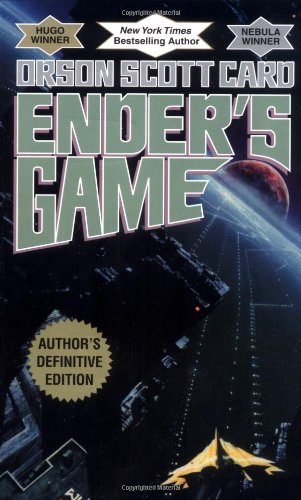All Nonfiction
- Bullying
- Books
- Academic
- Author Interviews
- Celebrity interviews
- College Articles
- College Essays
- Educator of the Year
- Heroes
- Interviews
- Memoir
- Personal Experience
- Sports
- Travel & Culture
All Opinions
- Bullying
- Current Events / Politics
- Discrimination
- Drugs / Alcohol / Smoking
- Entertainment / Celebrities
- Environment
- Love / Relationships
- Movies / Music / TV
- Pop Culture / Trends
- School / College
- Social Issues / Civics
- Spirituality / Religion
- Sports / Hobbies
All Hot Topics
- Bullying
- Community Service
- Environment
- Health
- Letters to the Editor
- Pride & Prejudice
- What Matters
- Back
Summer Guide
- Program Links
- Program Reviews
- Back
College Guide
- College Links
- College Reviews
- College Essays
- College Articles
- Back
Ender's Game by Orson Scott Card
Ender’s Game was The Hunger Games before there was The Hunger Games. It was Harry Potter before there was Harry Potter. Ender’s Game would seem to those who did not see the publication date like another one of those sci-fi, dystopian, adventure books in which there is a child or teenage protagonist who saves the day from impending doom. But to those who took note of when it was published, January 15th, 1985, they would know Ender’s game was one of the very first to set the tone for what is now a hugely popular trend in young-adult novels.
The novel is about the future of humanity and it depends on six year-old Andrew Ender Wiggin. The adults in charge of training Ender are impressed with his intelligence, his tactics, and his disposition towards violence and compassion. Convinced he is the one meant to save humanity, they push him further and further in training throughout his childhood. Ender’s battle is not only against the alien race humanity wishes to eliminate, but in his own head as well and against the people he is not sure he can trust.
Orson Scott Card created a fascinating world in which the reader lives: Ender’s mind. The mind game in particular showed what ender was really like on the inside. My interpretation was all metaphor. The game with the giant is his time in training. The giant is Colonel Graff, and everyone responsible for making Ender ready to command an army. The mouse is Ender. The rigged game shows if he chooses to play the game, to submit to the giant, then the giant wins. (Ender does in fact cooperate, and it is he who loses in the end by destroying the buggers’ home planet) If the mouse chooses to play the game by his own rules and fight back, the mouse wins and can move on with his life to explore independently. However, the giant is killed and loses in the end, representing the alternative ending to the story; the adults training Ender look the fool and their reputations are destroyed. The playground with the many children represents childhood games and immaturity. Ender can’t go on any of the playground equipment because he does not fit in with the immature, young minds because he is more advanced in his way of thinking and acting. However, the wolves with the children’s faces show the competition the children soon develop and how, when driven by some unseen force, it is deadly. After he defeats the children, they follow him, literally and metaphorically speaking. He comes to ‘The End of the World’ and attempts to hurl himself off the cliff, but a cloud stops him and brings him back to continue, representing his desire to stop, but the inability to. ‘He cared little, at the moment, what the game of this place might be. (…) And so, with no thought of consequences, he jumped from the ledge. Now he plummeted downward toward a roiling river and savage rocks; but a cloud came between him and the ground as he fell, and caught him, and carried him away.’ Page 73
The ending was pleasing. Ender is given all this opportunity to be violent and is encouraged to be violent. Violence controls the majority of his early life. Yet at the end, Ender can finally reject that. I think it’s nice how he can fully use both ‘sides’ of him. The Peter side; relentless, vicious, and unforgiving and the Valentine side; compassionate, kind, and understanding. He gets to be happy.
‘And always Ender carried with him a dry white cocoon, looking for the world where the hive-queen could awaken and thrive in peace. He looked a long time.’ Page 324
Similar Articles
JOIN THE DISCUSSION
This article has 0 comments.

